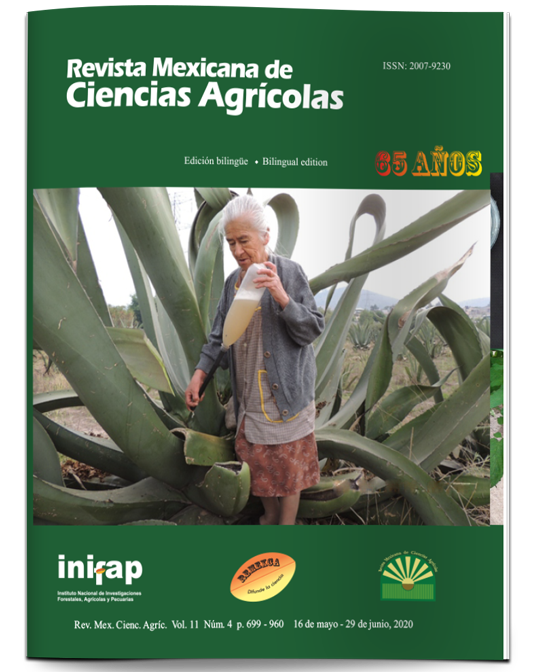Greenhouse trial of green manures on soil properties, chard production and environmental implications
DOI:
https://doi.org/10.29312/remexca.v11i4.2104Keywords:
Lablab purpureos L., Vigna unguiculata L., CO2, GHG, horticultureAbstract
In this trial, legumes dolichos beans (Lablab purpureos L. ex Sweet) and yorimon beans (Vigna unguiculata L. Walp) as green manures were studied. The objectives of the study were to evaluate the ability to capture carbon and fix nitrogen, as well as to measure the effects of its incorporation in the soil, the production of chard (Beta vulgaris var. cicla L.) and to analyze the environmental implications. In the results, L. purpureos produced 1 932 kg of dry matter in 90 days after sowing (869 kg ha-1 of C) and fixed 30 kg of N ha-1 in its tissues, while V. unguiculata produced 2 040 kg of dry matter in 80 days after sowing (918 kg ha-1 of C) and fixed 40 kg of N ha-1 in its tissues. The soil effects were not significant in both AV, compared to the control treatment (without AV). However, both promoted an increase in the weight of chard (40% in L. purpureos and 31% in V. unguiculata). Environmentally, green manures can reduce the carbon footprint by 280 kg ha-1 of CO2 equivalent by dispensing with synthetic nitrogenous chemical fertilizers in the production of chard. Green manures, as a source of nutrients, especially N, could form part of the integral management of the soil in the horticultural production systems of semi-arid zones.
Downloads
Published
How to Cite
Issue
Section
License
Copyright (c) 2020 Revista Mexicana de Ciencias Agrícolas

This work is licensed under a Creative Commons Attribution-NonCommercial 4.0 International License.
The authors who publish in Revista Mexicana de Ciencias Agrícolas accept the following conditions:
In accordance with copyright laws, Revista Mexicana de Ciencias Agrícolas recognizes and respects the authors’ moral right and ownership of property rights which will be transferred to the journal for dissemination in open access. Invariably, all the authors have to sign a letter of transfer of property rights and of originality of the article to Instituto Nacional de Investigaciones Forestales, Agrícolas y Pecuarias (INIFAP) [National Institute of Forestry, Agricultural and Livestock Research]. The author(s) must pay a fee for the reception of articles before proceeding to editorial review.
All the texts published by Revista Mexicana de Ciencias Agrícolas —with no exception— are distributed under a Creative Commons License Attribution-NonCommercial 4.0 International (CC BY-NC 4.0), which allows third parties to use the publication as long as the work’s authorship and its first publication in this journal are mentioned.
The author(s) can enter into independent and additional contractual agreements for the nonexclusive distribution of the version of the article published in Revista Mexicana de Ciencias Agrícolas (for example include it into an institutional repository or publish it in a book) as long as it is clearly and explicitly indicated that the work was published for the first time in Revista Mexicana de Ciencias Agrícolas.
For all the above, the authors shall send the Letter-transfer of Property Rights for the first publication duly filled in and signed by the author(s). This form must be sent as a PDF file to: revista_atm@yahoo.com.mx; cienciasagricola@inifap.gob.mx; remexca2017@gmail.
This work is licensed under a Creative Commons Attribution-Noncommercial 4.0 International license.



